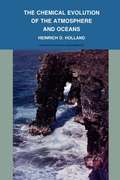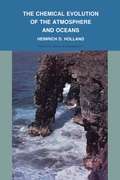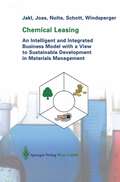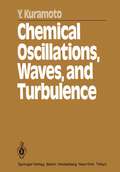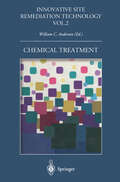- Table View
- List View
Chemical Evolution: Proceedings of the Fourth Trieste Conference on Chemical Evolution, Trieste, Italy, 4–8 September 1995
by Julian Chela-Flores François RaulinLeading researchers in the area of the origin and evolution of life in the universe contributed to Chemical Evolution: Physics of the Origin and Evolution of Life. This volume provides a review of this interdisciplinary field. In 35 chapters many aspects of the origin of life are discussed by 90 authors, with particular emphasis on the early paleontological record: physical, chemical, biological, and informational aspects of life's origin, instrumentation in exobiology and system exploration; the search for habitable planets and extraterrestrial intelligent radio signals. This book contains the proceedings of the Fourth Trieste Conference on Chemical Evolution that took place in September 1995, in which scientists from a wide geographical distribution joined in a Memorial to Cyril Ponnamperuma, who was a pioneer in the field of chemical evolution, the origin of life, and exobiology, and also initiated the Trieste Conferences on Chemical Evolution and the Origin of Life. This fourth Conference was therefore dedicated to his memory. Audience: Graduate students and researchers in the many areas of basic, earth, and life sciences that contribute to the study of chemical evolution and the origin of life.
Chemical Evolution: The Biological System of the Elements
by Bernd Markert Stefan Fränzle Simone WünschmannThis book is written for researchers and students interested in the function and role of chemical elements in biological or environmental systems. Experts have long known that the Periodic System of Elements (PSE) provides only an inadequate chemical description of elements of biological, environmental or medicinal importance. This book explores the notion of a Biological System of the Elements (BSE) established on accurate and precise multi-element data, including evolutionary aspects, representative sampling procedures, inter-element relationships, the physiological function of elements and uptake mechanisms. The book further explores the concept Stoichiometric Network Analysis (SNA) to analyze the biological roles of chemical species. Also discussed is the idea of ecotoxicological identity cards which give a first-hand description of properties relevant for biological and toxicological features of a certain chemical element and its geo biochemically plausible speciation form. The focus of this book goes beyond both classical bioinorganic chemistry and toxicology.
The Chemical Evolution of the Atmosphere and Oceans
by Heinrich D. HollandIn this first full-scale attempt to reconstruct the chemical evolution of the Earth's atmosphere and oceans, Heinrich Holland assembles data from a wide spectrum of fields to trace the history of the ocean-atmosphere system. A pioneer in an increasingly important area of scholarship, he presents a comprehensive treatment of knowledge on this subject, provides an extensive bibliography, and outlines problems and approaches for further research. The first four chapters deal with the turbulent first half billion years of Earth history. The next four chapters, devoted largely to the Earth from 3.9 to 0.6 b.y.b.p., demonstrate that changes in the atmosphere and oceans during this period were not dramatic. The last chapter of the book deals with the Phanerozoic Eon; although the isotopic composition of sulfur and strontium in seawater varied greatly during this period of Earth history, the chemical composition of seawater did not.
The Chemical Evolution of the Atmosphere and Oceans (Princeton Series in Geochemistry #2)
by Heinrich D. HollandIn this first full-scale attempt to reconstruct the chemical evolution of the Earth's atmosphere and oceans, Heinrich Holland assembles data from a wide spectrum of fields to trace the history of the ocean-atmosphere system. A pioneer in an increasingly important area of scholarship, he presents a comprehensive treatment of knowledge on this subject, provides an extensive bibliography, and outlines problems and approaches for further research.The first four chapters deal with the turbulent first half billion years of Earth history. The next four chapters, devoted largely to the Earth from 3.9 to 0.6 b.y.b.p., demonstrate that changes in the atmosphere and oceans during this period were not dramatic. The last chapter of the book deals with the Phanerozoic Eon; although the isotopic composition of sulfur and strontium in seawater varied greatly during this period of Earth history, the chemical composition of seawater did not.
Chemical Exchange Between the Atmosphere and Polar Snow (Nato ASI Subseries I: #43)
by Eric W. Wolff Roger C. BalesPolar ice cores have provided tremendous advances in our knowledge of past climate change. They also contain an archive of geochemical data, which can certainly delineate some of the forcing factors that govern climate change. However, our ability to interpret these data is severely curtailed by lack of knowledge of the processes governing the transfer of chemical species from the air to the snow. This book outlines the potential and problems of ice core chemistry and discusses the processes involved in air-snow transfer. It gives the state of current knowledge and an agenda for future research.
Chemical Fundamentals of Geology and Environmental Geoscience (Wiley Desktop Editions Ser.)
by Robin GillChemical principles are fundamental to the Earth sciences, and geoscience students increasingly require a firm grasp of basic chemistry to succeed in their studies. The enlarged third edition of this highly regarded textbook introduces the student to such ‘geo-relevant’ chemistry, presented in the same lucid and accessible style as earlier editions, but the new edition has been strengthened in its coverage of environmental geoscience and incorporates a new chapter introducing isotope geochemistry. The book comprises three broad sections. The first (Chapters 1–4) deals with the basic physical chemistry of geological processes. The second (Chapters 5–8) introduces the wave-mechanical view of the atom and explains the various types of chemical bonding that give Earth materials their diverse and distinctive properties. The final chapters (9–11) survey the geologically relevant elements and isotopes, and explain their formation and their abundances in the cosmos and the Earth. The book concludes with an extensive glossary of terms; appendices cover basic maths, explain basic solution chemistry, and list the chemical elements and the symbols, units and constants used in the book.
Chemical Fundamentals of Geology and Environmental Geoscience
by Robin GillChemical principles are fundamental to the Earth sciences, and geoscience students increasingly require a firm grasp of basic chemistry to succeed in their studies. The enlarged third edition of this highly regarded textbook introduces the student to such ‘geo-relevant’ chemistry, presented in the same lucid and accessible style as earlier editions, but the new edition has been strengthened in its coverage of environmental geoscience and incorporates a new chapter introducing isotope geochemistry. The book comprises three broad sections. The first (Chapters 1–4) deals with the basic physical chemistry of geological processes. The second (Chapters 5–8) introduces the wave-mechanical view of the atom and explains the various types of chemical bonding that give Earth materials their diverse and distinctive properties. The final chapters (9–11) survey the geologically relevant elements and isotopes, and explain their formation and their abundances in the cosmos and the Earth. The book concludes with an extensive glossary of terms; appendices cover basic maths, explain basic solution chemistry, and list the chemical elements and the symbols, units and constants used in the book.
Chemical Lake Restoration: Technologies, Innovations and Economic Perspectives
by Miltiadis G. Zamparas Grigorios L. KyriakopoulosThis book aims to structure, in a complete and sequential way, the mainstream technical knowledge which is related to eutrophication control. The book considers the development of innovative technologies for phosphate removal, while supporting the restoration of currently degraded lakes and reservoir systems. In addition, this book contains key-aspects of future benchmark interests being specially framed under the ongoing development of a circular economy. In particular, the book will contribute to a better understanding of the problem of internal P-loads and P-sources disposition towards a more effective control of nutrients’ enrichment in lakes. The chemical routes and environmental fate of such lake nutrients will be viewed in the light of innovative technologies (engineering dimensions) and circular economy perspectives (economics dimensions). The main theme extends to an economic appreciation of environmental polluted aquifers. The book will appeal to an interdisciplinary audience, covering a wide spectrum of scientific fields, such as environment, physical chemistry, surface chemistry, interfacial phenomena, coastal engineering, bio-engineering, environmental policy makers, and economists.
Chemical Leasing: An Intelligent and Integrated Business Model with a View to Sustainable Development in Materials Management
by Thomas Jakl Reinhard Joas Rainer Nolte Rudolf Schott Andreas Windsperger"Chemical leasing” represents an innovative business model, in which chemicals are no longer simply sold to the customer to render a specific service, but made available and maintained. This way, the economic interest no longer lies in selling the chemical product, but in providing a chemical service. All the stakeholders will thus endeavour to enhance the efficiency of the various substances to a maximum. This book is based on the results of two studies facilitated by the Austrian Ministry of Environment and key players of the industry, in which the potentials for the introduction of such a business model for Austria were investigated. A classical "win–win” solution evolves, which spares the environment by reducing emissions, gives rise to an optimisation of company processes, both in terms of quality and quantity, and redefines the supplier – customer relationship.
Chemical Master Equation for Large Biological Networks: State-space Expansion Methods Using AI
by Don Kulasiri Rahul KosarwalThis book highlights the theory and practical applications of the chemical master equation (CME) approach for very large biochemical networks, which provides a powerful general framework for model building in a variety of biological networks. The aim of the book is to not only highlight advanced numerical solution methods for the CME, but also reveal their potential by means of practical examples. The case studies presented are mainly from biology; however, the applications from novel methods are discussed comprehensively, underlining the interdisciplinary approach in simulation and the potential of the chemical master equation approach for modelling bionetworks. The book is a valuable guide for researchers, graduate students, and professionals alike.
Chemical Oceanography
by Frank J. MilleroOver the past ten years, a number of new large-scale oceanographic programs have been initiated. These include the Climate Variability Program (CLIVAR) and the recent initiation of the Geochemical Trace Metal Program (GEOTRACES). These studies and future projects will produce a wealth of information on the biogeochemistry of the world's oceans. Aut
Chemical Oceanography: Volume 5, Chemical Oceanography (Harte Research Institute For Gulf Of Mexico Studies Series, Sponsored By The Harte Research Institute For Gulf Of Mexico Studies, Texas A&m University-corpus Christi Ser.)
by Frank J. MilleroOver the past ten years, a number of new large-scale oceanographic programs have been initiated. These include the Climate Variability Program (CLIVAR) and the recent initiation of the Geochemical Trace Metal Program (GEOTRACES). These studies and future projects will produce a wealth of information on the biogeochemistry of the world's oceans. Aut
Chemical Oceanography of Frontal Zones (The Handbook of Environmental Chemistry #116)
by Igor M. BelkinThis book is a unique and authoritative review of chemical fronts in the world ocean. It includes regional chapters on chemical fronts in all major oceans (Atlantic, Indian, Pacific, Arctic, and Southern) and marginal seas (North Sea, Baltic Sea, Mediterranean Sea, Gulf of Mexico, Yellow Sea, and the East Siberian Sea). Thematic chapters focus on diverse topics such as cross-frontal transfer of nutrients; diapycnal mixing and its impact on nutrient fluxes in western boundary currents (Gulf Stream and Kuroshio); front-driven physical-biogeochemical-ecological interactions; dynamics of coloured dissolved organic matter; pollutant concentration and fish contamination in frontal zones; distribution of microplastics in the ocean, and Lagrangian methods to study the transport of marine litter. This volume will appeal to a broad audience, including researchers, instructors, students, and practitioners of all kinds involved in scientific and applied research, environment protection and conservation, and maritime industries including fisheries, aquaculture, and mining.
Chemical Oscillations, Waves, and Turbulence (Springer Series in Synergetics #19)
by Y. KuramotoTbis book is intended to provide a few asymptotic methods which can be applied to the dynamics of self-oscillating fields of the reaction-diffusion type and of some related systems. Such systems, forming cooperative fields of a large num of interacting similar subunits, are considered as typical synergetic systems. ber Because each local subunit itself represents an active dynamical system function ing only in far-from-equilibrium situations, the entire system is capable of showing a variety of curious pattern formations and turbulencelike behaviors quite unfamiliar in thermodynamic cooperative fields. I personally believe that the nonlinear dynamics, deterministic or statistical, of fields composed of similar active (Le., non-equilibrium) elements will form an extremely attractive branch of physics in the near future. For the study of non-equilibrium cooperative systems, some theoretical guid ing principle would be highly desirable. In this connection, this book pushes for ward a particular physical viewpoint based on the slaving principle. The dis covery of tbis principle in non-equilibrium phase transitions, especially in lasers, was due to Hermann Haken. The great utility of this concept will again be dem onstrated in tbis book for the fields of coupled nonlinear oscillators.
Chemical Petrology: with applications to The Terrestrial Planets and Meteorites
by R.F. Mueller S.K. SaxenaChemical petrology is essentially the physical chemistry of rocks and associated fluids, although it also borrows heavily from such other sciences as mineralogy. In terms of fundamentals it is firmly grounded in chemical thermodynamics and kinetics. In its treatment of terrestrial environments it grades imperceptably into sedimentology, geochemistry, and geophysics and in extraterrestrial environments into cosmochemistry. It is one of the most important branches of planetology and meteoritics. The unity of approach of thermodynamics and kinetics to processes in these diverse environments is stressed in this book by numerous examples which have been chosen to illuminate different aspects of the subject. Thus we have discussed in some depth such problems as the genesis of layered basic complexes, calc-alkaline batholiths, chondri tic meteorites, and the surface-atmosphere interaction of the planet Venus because these are important and because they are particularly good illustrations of the chemical petrology approach. Considerable attention also has been devoted to volcanic processes. In our treatment of metamor phism in particular, an attempt has been made to correlate and integrate the vast number of recent experimental, theoretical, and field studies. However, we have not attempted a comprehensive survey of all known rock types or occurrences, nor did we review all the diverse opinions and conclusions on the origins of controversial rocks. Instead we have chosen to stress interpretations we regard as following most directly from the evidence.
Chemical Physics of Free Molecules
by Norman H. March J.F. MucciIn this introductory chemical physics textbook, the authors discuss the interactions, bonding, electron density, and experimental techniques of free molecules, and apply spectroscopic methods to determine molecular parameters, dynamics, and chemical reactions.
Chemical Processes in Atmospheric Oxidation: Laboratory Studies of Chemistry Related to Tropospheric Ozone (Transport and Chemical Transformation of Pollutants in the Troposphere #3)
by GeorgesBrasOxidation and removal of atmospheric constituents involve complex sequences of reactions which can lead to the production of photo-oxidants such as ozone. In order to understand and model these complex reaction sequences, it is necessary to have a comprehensive understanding of reaction mechanisms and accurate estimates of kinetic parameters for relevant gas-phase atmospheric reactions. This book presents recent advances in the field and includes the following topics: e.g. the oxidation of simple organic compounds, NOx kinetics and mechanisms, OH radical production and rate constants for the OH attack on more complex organic compounds, peroxy and alkoxy radical reactions, photo-oxidation of aromatic and biogenic compounds, and the interaction between radical species.
Chemical Processes in Marine Environments (Environmental Science and Engineering)
by Antonio Gianguzza Ezio Pelizzetti Silvio SammartanoChemical Structure of Pelagic Redox Interfaces: Observation and Modeling (The Handbook of Environmental Chemistry #22)
by Evgeniy V. YakushevOver the last few decades many studies have focused on the oxygen depletion of coastal and oceanic waters. An understanding of the processes involved is fundamental to assess the effects of global and climatic changes and to support an ecosystem approach to adaptive environmental management for coastal seas and ocean basins.This timely book presents the state-of-the-art of our knowledge of the nature and chemical structure of redox interfaces in a marine water column, oxygen depletion and connected processes. The structures of the redox layers, including the distribution of certain parameters and microbiological features, are described in detail. The volume also covers studies devoted to the interannual variability of some oxygen-depleted systems, modeling and new developments in observation techniques. In addition, it identifies remaining gaps in our knowledge of the cycling of chemical elements in changing redox conditions. The chapters are based on extensive observational data, collected by the authors during sea and shore expeditions, on archive data, and on a broad range of scientific literature.
Chemical Transport in Metasomatic Processes (Nato Science Series C: #218)
by Harold C. HelgesonAs indicated on the title page, this book is an outgrowth of the NATO Advanced Study Institute (ASI) on Chemical Transport in Metasomatic Processes, which was held in Greece, June 3-16, 1985. The ASI consisted of five days of invited lectures, poster sessions, and discussion at the Club Poseidon near Loutraki, Corinthia, followed by a two-day field trip in Corinthia and Attica. The second week of the ASI consisted of an excursion aboard M/S Zeus, M/Y Dimitrios II, and the M/S Irini to four of the Cycladic Islands to visit, study, and sample outstanding exposures of metasomatic activity on Syros, Siphnos, Seriphos, and Naxos. Nine teen invited lectures and 10 session chairmen/discussion leaders participated in the ASI, which was attended by a total of 92 professional scientists and graduate stu dents from 15 countries. Seventeen of the invited lectures and the Field Excursion Guide are included in this volume, together with 10 papers and six abstracts representing contributed poster sessions. Although more than two years has elapsed since the ASI, all of the papers in this volume are up to date, and each has benefited from stimulating discussion, critical comment, and scientific interaction, both at the ASI and in the subsequent peer review process. The scientific emphasis of the ASI focused initially on upper mantle metasoma tism and crust/mantle interaction. Isotopic evidence was presented indicating that upper mantle peridotites have undergone nonequilibrium metasomatic exchange with an external oxygen-bearing fluid.
Chemical Treatment (Innovative Site Remediation Technology #2)
by William C. AndersonThis monograph on chemical treatment is one of a series of eight on innovative site and waste remediation technologies that are the culmination of a multi organization effort involving more than 100 experts over a two year period. It provides the experienced, practicing professional guidance on the application of innovative processes considered ready for full-scale application. Other monographs in this series address bioremediation, soil washing/soil flushing, solvent chemical extraction, stabilization/ solidifica tion, thermal desorption, thermal destruction, and vacuum vapor extraction. 7. 7 Chemical Treatment The term chemical treatment, as used in this monograph, refers to the use of reagents to destroy or chemically modify target contaminants by means other than pyrolysis or combustion. The monograph addresses processes that chemically treat contaminated soils, groundwaters, surface waters, and, to a limited extent, concentrated contaminants. Chemical treatment is a means of converting hazardous constituents into less environmentally ob jectionable forms in order to meet treatment objectives. This monograph addresses substitution, oxidation, and chemical precipi tation processes. It addresses processes within these classes that are suffi ciently advanced for full-scale application. There are a number of emerging technologies within these classes that are in the research or an early devel opment stage, not yet ready for full-scale application, that appear to be very promising technologically. Six such technologies are briefly addressed in Appendix A.
Chemical Water and Wastewater Treatment: Proceedings of the 4th Gothenburg Symposium 1990 October 1–3, 1990 Madrid, Spain
by Hermann H. Hahn Rudolf KluteThe biennial International Gothenburg Symposia on Chemical Water and Waste water Treatment have proven to be a unique platform for the exchange of ideas and experiences between administrators, engineers and scientists active in the fields of water supply, wastewater disposal and pollution control. The First Symposium (Gothenburg, 1984) provided a long needed survey over theory and application of chemical water and wastewater treatment. The Second Symposium (Berlin, 1986) was devoted to aspects of recycling in chemical water and wastewater technology. The Third Symposium (Gothenburg, 1988) recognised the growing need and the potentials of pretreatment. These proceedings of the 4th Symposium focus on technology transfer from chemical treatment theory to practical treatment of drinking water and industrial or domestic wastewater. The contributions are devoted to questions of floc for mation and floc separation as well as problems and practical solutions associated with chemicals and dosing control. Special attention is given to the combination of chemical and biological processes for nutrient removal from wastewater. It is the editors' privilege to acknowledge the invaluable help from the authors of this book. It is the editors' hope that they might convey the significance and potential of chemical treatment in solving the challenging problems water purification, wastewater disposal and pollution control.
Chemical Weathering of Limestone (tactile)
by RnibThis is a tactile diagram for GCSE level students. The diagram consists of two pages: a key and a cross section diagram of a river flowing underground. Users start in the top right of the diagram. A textured section shows the softening limestone, and users follow the tactile river into a cave, where sections of rock are labelled, as well as stalacmites and stalagtites.
Chemical Weathering - Pavement and Cave (large print)
by RnibThis is a two-page document showing how the action of acidic rain causes weathering and degradation of limestone rock. Dashed line image borders surround the diagrams. There is a locator dot shown, which will be at the top left of the page when the image is the correct way up. The first page is a labelled cross section diagram of limestone rock with water running through a cave and an area of limestone pavement on the surface of the rock. The second page shows an enlarged view of the limestone pavement in plan and cross section views. Page 1: On this page the limestone rock is shown in cross section. The rock occupies the bottom half of the page. In the centre right of the image is a stream of acidic water, represented by a heavy dashed line, flowing to the left down a hill. It falls into the mouth of a swallow hole to a cave caused by the water dissolving away the rock it flows through. It continues to the left and eventually streams out of the rock at the bottom left of the page. There are stony spikes on the roof and floor of the cave: a stalactite and stalagmite made by dripping water depositing its dissolved limestone. The surface of the rocky area runs across the centre of the page. It has been eroded by the action of acidic water and has vertical cracks going down into the rock, called joints and grykes. Page 2: There are two diagrams on this page. At the top of the page there is a plan view of the limestone pavement shown on page one. The pavement is criss-crossed by a network of cracks in a pattern of squares, giving the surface of the rock the appearance of street pavement. The square sections are called clints. At the bottom of the page the pavement is shown in a cross section side view. The deep cracks are joints and the shallower cracks are grykes.
Chemical Weathering - Pavement and Cave (UEB contracted)
by RnibThis is a two-page document showing how the action of acidic rain causes weathering and degradation of limestone rock. Dashed line image borders surround the diagrams. There is a locator dot shown, which will be at the top left of the page when the image is the correct way up. The first page is a labelled cross section diagram of limestone rock with water running through a cave and an area of limestone pavement on the surface of the rock. The second page shows an enlarged view of the limestone pavement in plan and cross section views. Page 1: On this page the limestone rock is shown in cross section. The rock occupies the bottom half of the page. In the centre right of the image is a stream of acidic water, represented by a heavy dashed line, flowing to the left down a hill. It falls into the mouth of a swallow hole to a cave caused by the water dissolving away the rock it flows through. It continues to the left and eventually streams out of the rock at the bottom left of the page. There are stony spikes on the roof and floor of the cave: a stalactite and stalagmite made by dripping water depositing its dissolved limestone. The surface of the rocky area runs across the centre of the page. It has been eroded by the action of acidic water and has vertical cracks going down into the rock, called joints and grykes. Page 2: There are two diagrams on this page. At the top of the page there is a plan view of the limestone pavement shown on page one. The pavement is criss-crossed by a network of cracks in a pattern of squares, giving the surface of the rock the appearance of street pavement. The square sections are called clints. At the bottom of the page the pavement is shown in a cross section side view. The deep cracks are joints and the shallower cracks are grykes.


